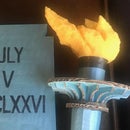Introduction: The Best Dollar Bill Paper Airplane: the Material Gull
The title is not clickbait: this original design really is the optimum performance glider that can be made from a dollar bill, or at least close to it. To me, the "best" paper airplanes are the ones with the slowest glide and the shallowest glide slope, when they float along like magic.
Why it works: it has a large wing area and a high aspect ratio wing given the paper we're working with, along with "diffuser tips" for stability and trim.
Compromises: pitch stability because it's short and almost tail-heavy, yaw stability also because it's short, roll stability... In other words, it's fairly twitchy to trim!
Not every flight is perfect, but with accurate and symmetric folding, practice with throwing, fine-tuning, and a little luck, every so often you'll get a magical flight.
Supplies
Cheap, just a buck! Or not so cheap, if you use something other than Washingtons. (I'd be curious to see how non-USA currencies perform.) Use the crispest bill in your wallet.
Step 1: Basic Shape
Fold the bill in half, taking care to match the corners.
Fold the upper corner to meet the lower edge, with the crease starting from the end of the center fold. Do the Same Thing On The Other Side (STOTOS), making sure it matches symmetrically.
Fold the flap's corner up so that its edge just about matches the diagonal fold. STOTOS.
Step 2: Leading Edges
Unfold the big diagonal fold. STOTOS.
Fold the creased edge to just about match that diagonal fold line. STOTOS.
Unfold the corner flap. STOTOS.
Fold the flaps's corner back up so that it just about matches the diagonal crease. STOTOS.
Re-fold the big diagonal fold, and press it flat. STOTOS.
Step 3: Schnoz
Unfold the center fold.
Fold the point down in the middle, to a level around George's chin. The crease should be about at the top of the "IN GOD WE TRUST" lettering that's on the underside.
Fold the point back up to the creased edge.
Step 4: Wings
Re-fold the center fold.
Starting from just below the leading edge folds, fold the wing down, with the crease at a 10-15° angle relative to horizontal. (Ignore the extraneous creases in the photo.)
STOTOS, taking care that it matches symmetrically.
Step 5: Wingtip Fins
Unfold the wing folds. (Again, ignore the extraneous crease in the photos.)
Fold the tip down approximately as shown, with the crease at a 20-25° angle to horizontal. STOTOS.
Re-fold the wing folds so that the wings are out, and open up the tips.
Step 6: Leading Edge Curvature
Curl the leading edge of each wing down a bit. It helps smooth the airflow over the top of the wing, for more lift and less drag. You don't have to overdo it though.
Step 7: Tail Volume
While holding the nose together, pooch out the back end of the body. The widened tail helps with yaw stability, and spreading the backs of the wings apart reduces the sweep angle, which helps with pitch stability.
Step 8: Finishing Touches
Crisp up the folds as needed. Sight along the front and back, and straighten out any asymmetries. When the plane is released, it should fly with the wings at a slight dihedral angle, 10-20° relative to each other. The tips should be angled down about 40° relative to their respective wings.
Step 9: Fly, Trim, and Fly Again!
Launch the Material Gull with a smooth, slow, level motion (not upward). If it immediately loops up, slow down. If it immediately dips (even if it subsequently loops up), speed up a bit.
On the first attempts, the plane will probably porpoise up and down or veer off to one side. Try adjusting the wing dihedral and tip angles, changing them a little at a time. You might need to angle one tip fold slightly differently than the other, twist the tips of the wings back or forward a bit, flatten out some of the leading edge curvature, etc. Experience with flying regular paper airplanes can give you an idea of what else to try. It takes me a dozen or two throws to get a plane like this into trim.
A tuned plane on a perfect throw is a joy. It'll probably go out of adjustment in the next flight or two and need re-trimming, but don't despair, and treasure the good ones. Happy flying!




